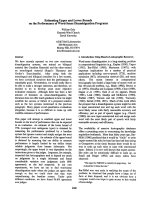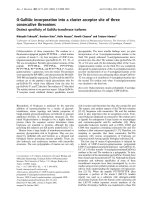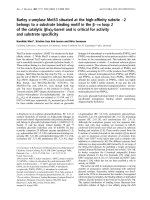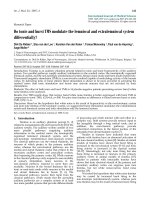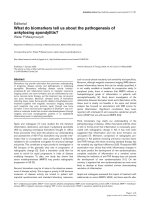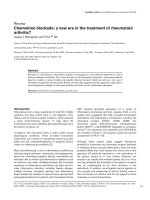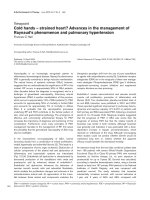Báo cáo y học: "Mechanical complications and reconstruction strategies at the site of hip spacer implantation"
Bạn đang xem bản rút gọn của tài liệu. Xem và tải ngay bản đầy đủ của tài liệu tại đây (4.09 MB, 6 trang )
Int. J. Med. Sci. 2009, 6
274
I
I
n
n
t
t
e
e
r
r
n
n
a
a
t
t
i
i
o
o
n
n
a
a
l
l
J
J
o
o
u
u
r
r
n
n
a
a
l
l
o
o
f
f
M
M
e
e
d
d
i
i
c
c
a
a
l
l
S
S
c
c
i
i
e
e
n
n
c
c
e
e
s
s
2009; 6(5):274-279
© Ivyspring International Publisher. All rights reserved
Review
Mechanical complications and reconstruction strategies at the site of hip
spacer implantation
Konstantinos Anagnostakos
1
, Jochen Jung
1
, Nora Verena Schmid
1
, Eduard Schmitt
1
, Jens Kelm
1,2
1. Klinik für Orthopädie und Orthopädische Chirurgie, Universitätskliniken des Saarlandes, Homburg/Saar, Germany
2. Chirurgisch-Orthopädisches Zentrum Illingen/Saar, Germany
Correspondence to: Dr. Konstantinos Anagnostakos, Klinik für Orthopädie und Orthopädische Chirurgie, Univer-
sitätskliniken des Saarlandes, Kirrbergerstr. 1, D-66421, Homburg/Saar, Germany. Tel.: 0049-6841-1624520; Fax:
0049-6841-1624516; e-mail:
Rec
eived: 2009.08.01; Accepted: 2009.09.02; Published: 2009.09.03
Abstract
Over the past two decades antibiotic-impregnated hip spacers have become a popular pro-
cedure in the treatment of hip joint infections. Besides infection persistence and/or reinfec-
tion, major complications after hip spacer implantation include spacer fracture, -dislocation,
and bone fracture. Moreover, in cases with extensive loss of femoral and/or acetabular bone
alternative reconstructive techniques should be used for a stable spacer fixation and pre-
vention of fractures or dislocations. The present article reviews the different types of spacer
fractures and dislocations and offers some suggestions about reconstructive techniques for
management of extensive loss of femoral and/or acetabular bone at the site of hip spacer
implantation.
Key words: hip spacers, spacer fracture, spacer dislocation, femoral fracture, reconstruction.
Introduction
Over the past two decades antibi-
otic-impregnated hip spacers have become a popular
procedure in the treatment of hip joint infections with
reported success rates of > 90 % [1]. Although initially
developed for the management of infected total hip
arthroplasties, hip spacers have been successfully
used also in the treatment of bacterial coxitis or infec-
tions of the proximal femur after osteosynthesis [4].
The major advantages of a hip spacer implantation
are: (i) immediate treatment of the infection source by
locally reaching high antibiotic levels, (ii) maintance
of joint mobility, (iii) limitation of scar formation, (iv)
absence of soft tissue contraction (usually resulting to
a leg length discrepancy) and (v) facility for reim-
plantation [1].
One of the major complications after hip spacer
implantation regards mechanical complications.
Spacer fractures and dislocations as well as femoral
fractures may endanger the functional outcome and
impede the later prosthesis reimplantation. Although
several reports have described these complications,
the exact incidence of these mechanical complications
is still unknown due to insufficient documentation or
differences in the precise definition of spacer disloca-
tions. Moreover, in cases with extensive loss of bone,
either on the femoral or acetabular side, there exist no
consensus as to which reconstructive procedure
should be performed that guarantees an infection
eradication and has a minimal risk regarding the
abovementioned mechanical complications.
In the past 10 years approximately 100 patients
have been treated in our department by hip spacer
implantation due to various hip joint infections. In
this article, we report our experience in the prophy-
laxis and treatment of mechanical complications at the
site of a hip spacer implantation and suggest some
Int. J. Med. Sci. 2009, 6
275
reconstructive techniques for management of exten-
sive loss of femoral and/or acetabular bone.
Mechanical complications and reconstruction
strategies
The exact rate of mechanical complications fol-
lowing hip spacer implantation remains unknown.
Despite numerous reports about these complications,
only Leunig and colleagues tried to interpret and ex-
plain these findings [6]. The authors have recognized
that the geometrical form of the spacer plays an im-
portant role. In spacers which were free of complica-
tions the neck to head-ratio was significantly lower
(0.76±0.05) than in those with dislocations (0.96±0.19).
A second factor associated with failure was an insuf-
ficient deep anchorage in the intramedullary canal,
being 22±33 mm in the failure group, while complica-
tion-free spacers were on average attached to a depth
of 57±41 mm.
Generally, a spacer dislocation might occur if
• the patient is not compliant,
• partial weight bearing of the operated extremity
cannot be tolerated,
• the spacer is insufficiently fixated onto the
proximal femur,
• the size of the spacer head is too small,
• large osseous defects of the acetabulum do not
allow for a normal spacer articulation, and
• a muscular insufficiency is present.
Moreover, the term “spacer dislocation” may
describe two different kinds of dislocation. A disloca-
tion may occur in the femoral canal due to an insuffi-
cient fixation technique, but the spacer head may re-
main in such cases in the acetabulum cup. The solu-
tion for this problem is to improve the femoral fixa-
tion of the spacer stem. Alternatively to that and at
stable femoral fixation, the spacer itself may dislocate
out from the hip socket. In these cases, specific atten-
tion should be paid on whether a wrong motion of the
hip joint led to the dislocation, the spacer head is too
small or extensive acetabular defects do no provide
enough primary stability for a normal spacer articu-
lation. In the former cases, the hip joint can be re-
duced and a conservative treatment in an orthesis can
be utilized.
Depending on the particular cause, treatment
options may strongly vary. In case of patient incom-
pliance or inability to put partial weight bearing on
the operated extremity, the patient should be rather
considered as a candidate for a resection arthroplasty
and not for a spacer implantation. For prevention of
any spacer dislocation due to an insufficient fixation
technique onto the proximal femur, a simple “press
fit” method should be avoided (Figure 1). Alterna-
tively, a partial (Figure 2) or normal cementation of
the spacer into the femoral canal provides the advan-
tage of rotational and axial stability [3]. A normal ce-
mentation has the disadvantage in comparison with
the partial cementation that all cement debris have to
be removed from the femoral canal during the later
prosthesis reimplantation, and that during removal of
the prosthesis stem osseous defects might occur. Re-
cently, the “glove”-technique has been described as
new method for femoral fixation of hip spacers [3].
This method provides a stable fixation onto the
proximal femur at facilitating the spacer’s explanta-
tion since the spacer can be removed at one piece and
there is no need for removal of any cement debris
compared with other normal cementation techniques.
In cases with muscular insufficiency or large
acetabular defects, the spacer should not be implanted
as a hemiarthroplasty, but rather as a total arthro-
plasty, consisting of a spacer stem and a cup (Figure
3). This is also of benefit in cases where the spacer
head is too small for the acetabulum cavity. Since not
every department has molds for production of spacers
in different sizes or lengths or the costs for commer-
cially available hip spacers are extremely high, the
orthopaedic surgeon is commonly faced with the di-
lemma: should a larger, hand-molded spacer head be
implanted (which, however, has the disadvantage of
an inferior articulation due to the uneven head surface
and form) or, alternatively, a spacer cup is inserted
into the acetabulum. We recommend the second op-
tion. This implantation technique also offers the ad-
vantage of a prevention of a spacer migration into the
pelvis (Figure 4) beside a normal articulation and
prevention of any spacer dislocation. Hereby, the ce-
ment-cement articulation promotes the emergence of
high local antibiotic concentrations due to the con-
tinuous friction of the articulating components. Ce-
ment debris can be then easily removed at the time of
the prosthesis reimplantation via pulsatile lavage and
debridement. However, in some cases with a com-
bined muscular insufficiency and large acetabular
defects a spacer dislocation might still occur. These
cases should be also considered as candidates for a
resection arthroplasty.
A spacer fracture can be either symptomatic or
asymptomatic depending on the fracture localisation.
Symptomatic fractures (Figure 5) are usually the con-
sequence of a spacer neck fracture and frequently
associated with a subsequent spacer head dislocation.
In these cases treatment should consist of revision
surgery and spacer exchange. On the other hand,
asymptomatic fractures are found in the middle or
lower part of the spacer stem (Figure 6) and usually
require no further operative treatment.
Int. J. Med. Sci. 2009, 6
276
For prevention of a spacer fracture, the surgeon
may consider inserting a metallic endoskeleton (Fig-
ure 7) into the spacer; however, literature data are
scarce about this topic. Schöllner et al. investigated in
vitro the mechanical properties of gentamicin-loaded
hip spacers after insertion of Kirschner wires [7].
Stress experiments showed an average failure load of
1.6 kN. The insertion of the K-wires prevented any
dislocation of the spacer fragments, but did not sig-
nificantly improve the mechanical properties. Kum-
mer et al. compared in vitro the mechanical properties
of commercially available hip spacers containing a
substantial stainless steel central core with experi-
mental spacers containing Steinmann pins, intrame-
dullary nails with two lag screws and Charnley
prostheses, respectively [5]. The authors reported that
all constructs based upon the Charnley prostheses
and the commercial spacers did not fail at 3000 N; the
other two constructs failed at significant lower loads
(pins at 832 N and nails at 1275 N, respectively). To
our knowledge, there are no clinical data available
that have demonstrated that the insertion of a metallic
endoskeleton significantly improves the mechanical
properties of hip spacers or reduces the rate of me-
chanical complications.
Moreover, it is still unclear whether the insertion
of a metallic endoskeleton has a negative influence on
the pharmacokinetic properties of the spacer. Ex-
perimental data have shown that the release of com-
mercially-impregnated antibiotics from hip spacers is
significantly increased in the presence of an endo-
skeleton, whereas the elution of additional, incorpo-
rated antibiotics is decreased [2]. Until this question is
answered, metallic endoskeletons should not be rou-
tinely inserted into hip spacers in clinical practise, but
only in exceptional cases for patients with a higher
fracture risk (high Body-Mass-Index, poor bone qual-
ity or osteoporosis).
Femoral fractures at the site of hip spacer im-
plantation should be treated when an unstable joint
situation results, the outcome of the surgery is en-
dangered or the mobilisation of the patient is hereby
limited. Generally, the surgical treatment of these
fractures should be planned taking into consideration
any further surgical revisions or the later prosthesis
reimplantation. If possible, the insertion of any metal-
lic implants should be avoided if the infection is not
completely eradicated for avoidance of an infection
persistence or reinfection. In difficult cases with a
nonsupportive proximal femur part, the treatment’s
choice should be made under consideration of both
infection sanitation and fracture management. In
cases, where the spacer stem does not exceed 10 cm
(in the majority of the cases), alternative reconstruc-
tive methods should be performed. In our experience,
the use of modular prosthesis systems or long nails
with an antibiotic-loaded cement mantle and a spacer
head is an elegant method that treats both the fracture
and the infection (Figure 8). At the time of prosthesis
reimplantation, the spacer head can be easily removed
and the modular prosthesis parts (neck and head)
placed. This procedure offers a stable fracture treat-
ment and facilitates the prosthesis reimplantation
regarding shorter surgery time, less blood loss and no
need for femoral exposure. Furthermore, this tech-
nique can be also applied in cases with large and ex-
tensive osseous defects of the proximal femur due to
the prosthesis loosening where a stable fixation of the
spacer to the proximal femur according to the usual
fixation techniques is not possible (Figure 9). Al-
though some hip spacers have the advantage of a long
stem (e.g. PROSTALAC) [8] and can be treated to a
similar manner as shown in Figure 8, not every clinic
has these spacers in hold; the above mentioned tech-
nique is a noble alternative to these constructs.
In conclusion, there exist several parameters and
factors that affect the mechanical properties of a hip
spacer in vivo. Knowledge about these parameters
may assist the physician to prevent and sufficiently
treat such complications. Future studies should in-
vestigate the ideal geometrical form for a hip spacer,
enhance the fixation techniques onto the proximal
femur and evaluate the effect of a metallic endo-
skeleton on the pharmacokinetic properties of the
interim prosthesis.
Conflict of Interest
The authors have declared that no conflict of in-
terest exists.
References
1. Anagnostakos K, Fürst O, Kelm J. Antibiotic-impregnated
PMMA hip spacers: current status. Acta Orthop 2006; 77:
628-37.
2. Anagnostakos K, Kelm J, Grün S, Schmitt E, Jung W, Swoboda
S. Antimicrobial properties and elution kinetics of line-
zolid-loaded hip spacers in vitro. J Biomed Mater Res B Appl
Biomater 2008; 87: 173-8.
3. Anagnostakos K, Köhler D, Schmitt E, Kelm J. The
„glove“-technique: a modified method for femoral fixation of
antibiotic-loaded hip spacers. Acta Orthop; in press.
4. Hsieh PH, Chang YH, Chen SH, Shih CH. Staged arthroplasty
as salvage procedure for deep hip infection following intertro-
chanteric fracture. Int Orthop 2006; 30: 228-32.
5. Kummer FJ, Strauss E, Wright K, Kubiak EN, Di Cesare PE.
Mechanical evaluation of unipolar hip spacer constructs. Am J
Orthop 2008; 37: 517-8.
6. Leunig M, Chosa E, Speck M, Ganz R. A cement spacer for
two-stage revision of infected implants of the hip joint. Int Or-
thop 1998; :209-14.
Int. J. Med. Sci. 2009, 6
277
7. Schöllner C, Fürderer S, Rompe JD, Eckhardt A. Individual
bone cement spacers (IBCS) for septic hip revision – prelimi-
nary report. Arch Orthop Trauma Surg 2003; 123: 254-9.
8. Wentworth SJ, Masri BA, Duncan CP, Southworth SB. Hip
prosthesis of antibiotic-loaded acrylic cement for the treatment
of infections following total hip arthrioplasty. J Bone Joint Surg
Am 2002; 84: 123-8.
Figures
Figure 1: Articulating hip spacer in situ, the spacer stem is
inserted into the femur according to a “press-fit” method.
Figure 2: Articulating hip spacer in situ, the partial cemen-
tation of the spacer onto the proximal femur provides a
rotational stability; at prosthesis reimplantation, the spacer
can be removed at one piece, leaving no cement particles in
the femoral canal.
Figure 3: Articulating hip spacer consisting of a spacer cup
and –stem.
Int. J. Med. Sci. 2009, 6
278
Figure 4: Spacer migration into the pelvis due to acetabular
defects.
Figure 5: Symptomatic spacer neck fracture with dislocation
in situ.
Figure 6: Asymptomatic spacer fracture localised in the
middle part of the spacer stem with no dislocation of the
spacer.
Figure 7: Antibiotic-loaded hip spacer with a metallic en-
doskeleton for enhancement of the mechanical properties.



